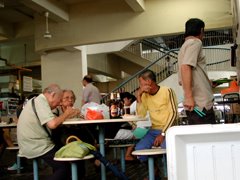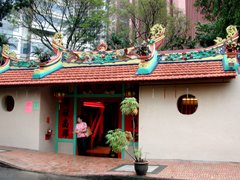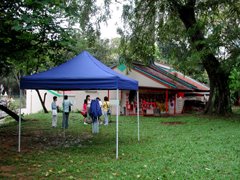
On 9 Nov 2006, which is the 19th of the 9th Lunar Month, at Tian Hock Keng, Xiang Lin Musical Association gave a Nan Yin and Li Yuan Xi performance, much to the delight of a dedicated audience. The average age of the group could well be the mid-70s, well, with some of us bringing the average lower. (^^) It was like yesteryears once more as the oldies - interestingly mostly men - sat, chat and enjoyed the show. And the performers, give a few older ones, the average age would be in mid-20s.
Well, we have hope that Nan Yin and Li Yuan Xi (literally translated as Pear Garden Opera .. the operas that were once the rave in the 1930s?) will be carried on to the next generation.
What better setting than at Tian Hock Keng, one of the oldest temples in Singapore, restored to its old glory .. bathed in warm light .. as the performers took the stage, which was the part of the courtyard just after the main doors. Tonight, the compere was a young lady. The man I was expecting was not there or could he be hidden in some masks as a performer? (^^)
The day, being the 19th of the 9th Lunar Moon, it was the third "Big Day" dedicated to Guan Yin, the Goddess of Mercy. The other days are 2M19 and 6M19. This musical association

conducts this performance at the Tian Hock Keng three times a year.
In tonight's performance, Xiang Lin has also invited the experts from Quan Zhou, China, one who is a flautist and the other, a lady who was the expert drummer (percussionist). She has an interesting technique in controlling the drums, making various sounds with sticks, hands and her foot!
In the typical Nan Yin tempo and starting, we were treated to the first piece, followed by singing by two girls, said to have learnt only for 3 months. For me, it could take a lifetime. Learning the Nan Yin's Hokkien (minnan hua) is not easy. Lyrics were projected to a screen, and so we were able to enjoy the songs better following the words and understanding the meaning.
If I am not wrong, in the group was a Malay guy who played the "sa-mi-sen" (three strings?). The first time I saw him was at ACM where he played the guzheng.
The music piece and the singing piece dedicated to Guan Yin was a great piece singing about the three Big Days dedicated to Guan Yin. The lyrics were written by Ding Ma Chen and the music composed by Zuo Sheng Xiang, both members of the Association. The ladies took turn to sing each "Big Day" of Guan Yin. As is the tradition now, after this song, led by an elder lady, who I guess must be the patron of the Association, the senior members and the VIPs, with the audience facing towards Guan Yin who is at the rear Hall (the front hall being dedicated to Mazu) bowed three times.

The music piece and the singing piece dedicated to Guan Yin was a great piece singing about the three Big Days dedicated to Guan Yin. The lyrics were written by Ding Ma Chen and the music composed by Zuo Sheng Xiang, both members of the Association. The ladies, include Mdm Wu, took turn to sing each "Big Day" of Guan Yin.
As is the tradition now, after this song, led by this elder lady, who I guess must be the patron of the Association, the senior members and the VIPs, with the audience facing towards Guan Yin who is at the rear Hall (the front hall being dedicated to Mazu) bowed three times.
The second part of the show was more lively with the Li Yuan Xi. I thought this performance is much better than the present day Hokkien Opera, but well. Excerpts from Tan Sa Gor Niu (Chen San Wu Niang) were performed in three parts, each with different actresses. It was an opera about this man from Quan Zhou (Tan Sa - 3rd Tan) who met this lady in Chao Zhou (Gor Niu - 5th Lady) ... which left the old men wanting for more. (^^) Yes, we were literally "sucked" into the scene where Tan Sa was leaving, heartbroken and disappointed and was pulled back by the maid (the umbrella episode) who played the go-in-between for Gor Niu to express her real feelings so as to convince Tan Sa to stay.

I agreed readily that this was much better than the street \noperas. (^^)
And so, the show ended with a very high note for all of us panting for more .. what a pity that only the ah-laos can appreciate it better and this show should have been shown to more people. A showcase of one of our heritage.
 Each time, as I drive past this unique building, a beauty amongst the beasts, I could not help thinking back of the days when its front could not even be seen from the road. In the old days, my young days, there was a big colony of food stalls just in front of the Tong Chek Yi Yii (as spoken in Hokkien, and often, we just called it Tong Chek Yi), selling all the delicious food. At my time, when one mentioned Tong Chek Yi, food came to my mind. Not the free TCM (traditional Chinese medicine) that it was offering to the locals.
Each time, as I drive past this unique building, a beauty amongst the beasts, I could not help thinking back of the days when its front could not even be seen from the road. In the old days, my young days, there was a big colony of food stalls just in front of the Tong Chek Yi Yii (as spoken in Hokkien, and often, we just called it Tong Chek Yi), selling all the delicious food. At my time, when one mentioned Tong Chek Yi, food came to my mind. Not the free TCM (traditional Chinese medicine) that it was offering to the locals.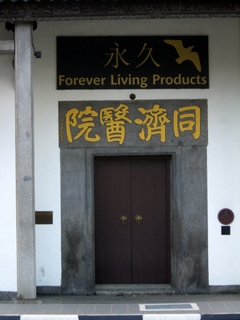 day, Tong Chek Yi Yii is still doing a wonderful community service, in a much bigger building, a short distance away, where the kaling (mynah) flies. But this beauty, deserted and left to fan for herself, has lost her soul. She is still crying out for the right one to give her back her soul.
day, Tong Chek Yi Yii is still doing a wonderful community service, in a much bigger building, a short distance away, where the kaling (mynah) flies. But this beauty, deserted and left to fan for herself, has lost her soul. She is still crying out for the right one to give her back her soul.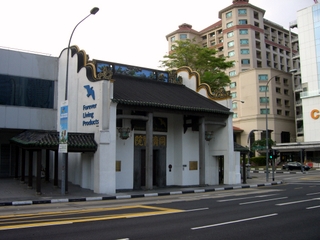 Tong Chek Yi 'Square' was the "opening" to an interesting part of Singapore, known to the Teochews (this place is the Teochew part of Chinatown) as Cha Chun Tao (the wooden boat quay in Teochew). I remember the wonderful Teochew Raw Fish, a different and lesser known version of Chinese raw fish, being sold at his old kopitiam (coffeeshop). Those interesting scenes of ancient Singapore are but memories. Thanks to this wonderful Singapore watcher, Ronni Pinsler, you can get to see many pictures of this part in the National Heritage Board Archive website.
Tong Chek Yi 'Square' was the "opening" to an interesting part of Singapore, known to the Teochews (this place is the Teochew part of Chinatown) as Cha Chun Tao (the wooden boat quay in Teochew). I remember the wonderful Teochew Raw Fish, a different and lesser known version of Chinese raw fish, being sold at his old kopitiam (coffeeshop). Those interesting scenes of ancient Singapore are but memories. Thanks to this wonderful Singapore watcher, Ronni Pinsler, you can get to see many pictures of this part in the National Heritage Board Archive website.

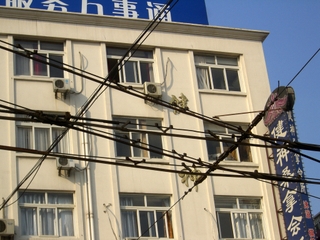




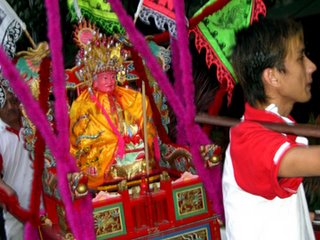



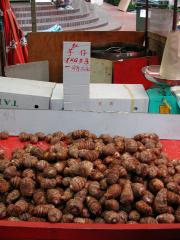





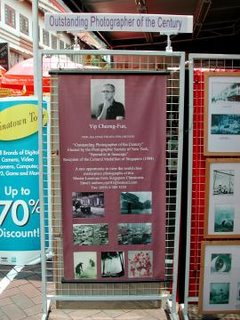



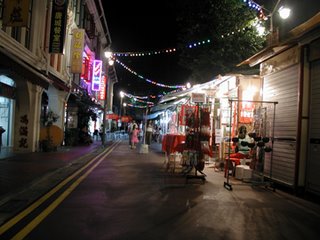



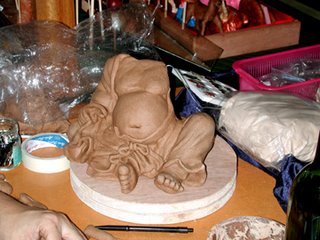






 On Saturday night of 18 March, 2006, Tian Hock Keng (Guan Fu Gong 天福宫) opened its door to one of the rare concerts on Nan Yin 南音 - Southern Music. Once popular with the Emperor's Court from Tang Dynasty through Qing Dynasty, today, it is heartening to know that there are still groups of young people and old involved in practising and keeping this arts alive.
On Saturday night of 18 March, 2006, Tian Hock Keng (Guan Fu Gong 天福宫) opened its door to one of the rare concerts on Nan Yin 南音 - Southern Music. Once popular with the Emperor's Court from Tang Dynasty through Qing Dynasty, today, it is heartening to know that there are still groups of young people and old involved in practising and keeping this arts alive.





